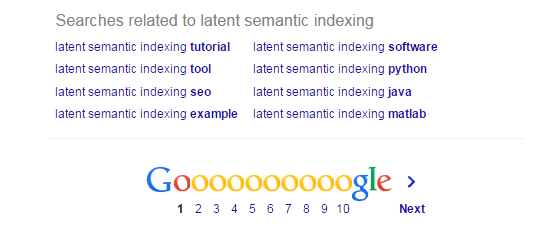Google Search is the Toughest English Teacher: 3 Rules for Search You Learned in High School
Sure, you thought Google search was a dream come true when you didn’t have to type well or spell correctly to find the right answer in your search return. But when you’re trying to navigate Google search rules in order to get your site seen, you may soon realize that having paid attention in high school English class finally has a pay-off.
Everyone Has One: A Bit of Advice About Playing by Google’s Search Rules
There are many bits of advice about publishing that may be attractive and interesting, but don’t necessarily adhere to Google’s search rules.
One of the recurring themes I read about in the digital marketing sphere is about building a strong content strategy to improve search ranking. Some of my favorites are: Keep an editorial calendar and publish often; learn what your competitors are writing about and steal their ideas (more politely called “tactical competitive auditing,” by search marketing maniac Neil Patel); and my very favorite, get published in national media sites.
People like me who have worked in national media for years can tell you that that last suggestion is a pipe dream unless you’re a big company with a media relations coordinator who spends all her time trying to get you on national media. Or you committed some random news of the weird, which is probably not how you want to get face time. Better option: Go for local coverage in most cases.
In any case, Google, like my high school creative writing teacher, Peggy Pfeiffer, is a taskmaster (I still can’t believe the “D+” I got for my interpretation of Grateful Dead lyrics, although looking back it is true that I may not have known at the time what they were talking about).
But there are some solid strategies when it comes to Google search rules that Google will reward you for, and a lot of them deal with going back to high school English class basics. This is especially true for small or local businesses. They can gain traction by adopting some tried and true standards that seem obvious to those of us who enjoyed diagramming English sentences (Of course, there’s a reason some of us ended up in journalism and digital marketing while others of us are rocket scientists.).
In honor of Ms. Pfeiffer, whom I spent years trying to get out of my head, and also just to give a virtual high-five to my wonderful journalism teacher, Mrs. Jensen, these three high school English class lessons are true drivers for getting seen in Google search.
1. Write Long
Does anyone remember when your high school teachers told you that your essays had to be a certain number of pages? I do. I didn’t really understand at the time that the goal wasn’t to keep me up late on Sunday night or to give the teachers more headaches, but that they wanted me to demonstrate my knowledge.
And so does Google.
Writing long doesn’t mean writing nonsense, or merely filling space with a lot of words. Writing long means offering clear, authoritative guidance and making sure that the content of your post is executed well enough for the machines to read and evaluate for their utility.
In other words, Google uses an algorithm that isn’t based merely on word count (though more than 400 words per post is a good start). It’s based on quality of the content and Google’s ability to decipher whether your material, in the scheme of all the material out there, has value for people searching for a particular topic.
So don’t be garrulous or redundant or merely verbose (shout-out to the teachers). Instead, know what you’re talking about. Be helpful and insightful and generous with your knowledge.
2. Long-Tail Keywords
OK, it was never called this in high school, but basically, where journalism tells you to home in on the most precise word you can find, creative writing allows you to be expressive and non-linear and outside the box. And that’s a super helpful exercise when you’re trying to describe things, which is what you’re trying to do by creating long-tail keywords for search engines.
The best part of using long-tail keywords is the hunt for long-tail keywords. There’s no serious science involved. You can use all sorts of search tools that help you to discover keyword combinations (Surprisingly or not, Google Keyword Planner, a tool found in Google’s AdWords service — free, but a hook for lurching you toward spending ad dollars on Google — is among my least favorite). Many keyword tools are available for free or have paid versions with an array of nifty functions. Find one you like on this amazing and exhausting list put together by SmallBusinessIdeasBlog.com.
The hunt for long-tail keywords is useful because it’s mind-expanding — and a good ego check. Not everyone thinks the way you think, and sometimes what you think you will find is completely opposite of what you do find. Example: You may want to search for a new tool to buy as a gift for your very handy husband, so you look up “new tool.” Except that Tool is a band that has a new album out. It’s also a slang expression for a fool. It’s also a word to describe a keyword planner. So you see where this is going. If you thought you were going to be taken to Home Depot or Amazon, you’d be wrong.
Even better, Home Depot and Amazon know that the phrase “new tool” isn’t really that valuable on its own, that there’s a band and a slang term and a bunch of other options for those words, and so they aren’t going to waste time, energy, or money trying to drive you to their site with that keyword. They are building long-tail keywords to direct you to them. They know you want something specific and they want you to find it, and when you get to their site, roam for more.
The “cheat” I like to use in long-tail keyword hunts is merely to start typing words in Google’s search window. It tells me all kinds of things that I may not have otherwise thought. I type in “tool gift” and it gives me “tool gift ideas for dad.” Forgetting the Electra Complex for a minute (this search works for both my husband and my father), using a long keyword chain on my site makes me more specific to the search, which means if I’m a match for what you wanted, you might just spend more time on my page, which means Google registers in its HAL-size brain that my site is good for you and people searching for items like you, and then it rewards me for being good by pushing my site up the search engine results page.
So, I look around for ideas to represent what I mean. I develop a whole bunch of long-tailed keywords that may be longer than my journalism teacher preferred, but are making my English teacher very happy. And Google is thanking me for it by showing my site to search traffic.
3. Latent Semantic Indexing
Yes, I know. I too believed there would be no math. But what did you expect when you’re dealing with Google. They put my college-level symbolic logic class (math for English students) to shame.
Still, this concept is not as difficult as it would seem. Latent Semantic Indexing does use math, but you don’t have to.
LSI basically comes down to the big machines looking around for words that go with your words and determining their relevance. I imagine how it came about is that really dorky, smart guys took words and replaced them with symbols and then combined them with other types of symbols in order to determine likely combinations of meanings. And then it spit all that back out as words. Why they couldn’t just use words is because … math, but this is another one of those examples where the scientists have made the world easier to navigate.
LSI follows word patterns. It categorizes ideas. It weeds out words that are spelled the same but have different meanings. It tells you what you mean when sometimes you don’t know what you mean. It comes in handy for those who want to know what goes with what. It makes the use of plus signs in search a little less necessary.
LSI is good for those who like to write but don’t want to sound like a broken record. In my English class, we would have called LSI an advanced thesaurus. It identifies synonyms, but one better. The synonyms don’t have to be one-word descriptions. They can be entire concepts, phrases that mean the same thing but are written slightly differently. And it combines them in short groupings so you can pick the best options for you and go update your site with them.
LSI is great for pairing concepts to determine whether what someone wants is actually what you are offering.
It’s just like making dinner. You need a starch, a protein, and something else. Come to think of it, I didn’t do so well in home economics. But I sure cook now.



